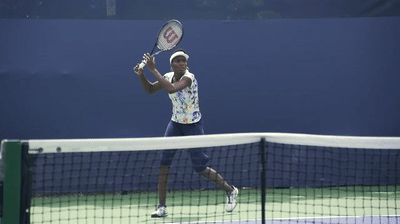WesternCK
Rookie
I don't understand why that PTD position would help rec players get below the ball... Heavy topspin can be produced with a low to high swing path and racquet on edge, like Venus. Although I hear many coaches, including Christophe, say PTD position will generate more topspin.
Venus averages 2100 RPM. Federer 2600 RPM.

Pat the dog can be a cue used to help players for different reasons. If I see a player not getting below the ball enough and either hitting extremely flat and/or downward into the net, I may use the pat the dog terminology to help them visualize getting below the ball. If I emphasize that the dog is a wiener dog, then all the better. As you said, topspin can be generated using a low to high swing and that's exactly the point. We can say that this isn't the exact meaning of "pat the dog" but that's to be debated over a forum and the success I see on the courts using the term once in a blue moon speaks for itself. Sometimes I do use it to emphasize a more closed face in the slot but much of the time that is only a secondary or tertiary element I would be trying to work on.
Of course, we eventually don't want the player to be thinking "pat the dog" in match play but if it helps them get the feeling of getting below the ball prior to contact, depending on the student, it can be more effective than saying something along of "loosen your grip" or "bend your knees" in order to get below the ball.
You're correct. It has nothing to do with getting below the ball. It's about being able to consistently add more spin. So you can hit harder without having to sort out every single shot as a new problem. Relatively.
Funny how one of the major ways to generate better topspin is to get below the ball. One can have an extremely closed face and then enjoy bashing balls into the net with nice racket head speed due to the fact that they're not dropping the racket head prior to contact. The two go hand in hand and while I'm sure the original intention of the expression may have been to ensure a closed face by patting the dog on the head with one's strings, I think it's incorrect to say that on court a term such as this wouldn't be able to be used as a mental cue to be able to get below the ball. As I said, I often like to point out that the dog is very short and tiny!
It's a very good question and in the common use of the word I would have to say no, it's not. With that being said, from the few forehands that I took a look at, Roger isn't using his legs much either or doing anything at all to even attempt getting below the ball. If the racket doesn't drop enough, pat the dog can only refer to a closed face in that position.@WesternCK @Limpinhitter
I took a quick look at JY's video newsletter. I believe he indicated that Roger will sometimes get to a (PTD) position similar to the one shown in your image but, quite often (more often than not?), he does not. In the video below, we see Roger's racket orientation similar to the position shown in your image. However, for his subsequent FHs, the racket orientation d quite different -- often closer to vertical than horizontal. Is that still PTD?
If he was dropping the racket lower, I would argue that it could be. If you have a player who is very tense, prepares chest height and doesn't have much racket drop, imagine what they will look like hitting a ball at waste height or knee height. Quite often, they will actually be hitting downward on the ball. If I were to say pat the dog on the head "down here" with their racket, I'd imagine it would have to be a pretty tall dog for them not to drop the racket head lower than they were prior to me saying that. I will repeat that there are instances where I will stop them in their tracks and emphasize a more closed face in that position, but there are other players I will completely ignore it and be happy even if they "pat the dog" with the edge of their racket, similar to what Roger would be doing here if he were to drop the head even lower than he is.



